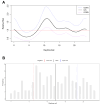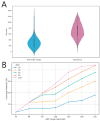Out-of-Hospital Cardiac Arrest Ambulance Delay Zones and AED Placement in a Southern Brazilian City
- PMID: 40003399
- PMCID: PMC11855518
- DOI: 10.3390/ijerph22020173
Out-of-Hospital Cardiac Arrest Ambulance Delay Zones and AED Placement in a Southern Brazilian City
Abstract
Out-of-hospital cardiac arrests (OHCAs) have high mortality rates, worsened by limited access to automated external defibrillators (AEDs). This study analyzed OHCA response times, identified areas with prolonged ambulance travel times, and proposed optimal AED locations in a medium-sized city in southern Brazil. Data from 278 non-traumatic OHCA cases (2019-2022) in patients over 18 years old, with ambulance response times under 20 min, were included. Spatial survival analysis assessed the probability of exceeding the recommended 5-min (300 s) ambulance response time. The maximal covering location problem identified 100 strategic AED sites within a 150-s reach for bystanders. AED and ambulance travel times were compared using the Wilcoxon test (p < 0.01). Defibrillation occurred in 89 cases (31.01%), and bystander CPR was performed in 149 cases (51.92%). Despite these efforts, 77% of patients died. The median ambulance response time was 11.63 min, exceeding 5 min in most cases, particularly at peak times like 11 a.m. AED placement in selected locations could cover 76% of OHCA occurrences, with a mean AED travel time of 320 s compared to 709 s for ambulances. Strategic AED placement could enhance early defibrillation and improve survival outcomes.
Keywords: automated external defibrillators; cardiopulmonary resuscitation; computer simulation; out-of-hospital cardiac arrest; spatial analysis.
Conflict of interest statement
The authors declare no conflicts of interest.
Figures







Similar articles
-
Semi-autonomous drone delivering automated external defibrillators for real out-of-hospital cardiac arrest: A Danish feasibility study.Resuscitation. 2025 Mar;208:110544. doi: 10.1016/j.resuscitation.2025.110544. Epub 2025 Feb 15. Resuscitation. 2025. PMID: 39961490
-
Drone delivery of automated external defibrillators compared with ambulance arrival in real-life suspected out-of-hospital cardiac arrests: a prospective observational study in Sweden.Lancet Digit Health. 2023 Dec;5(12):e862-e871. doi: 10.1016/S2589-7500(23)00161-9. Lancet Digit Health. 2023. PMID: 38000871
-
Automated external defibrillator accessibility is crucial for bystander defibrillation and survival: A registry-based study.Resuscitation. 2019 Mar;136:30-37. doi: 10.1016/j.resuscitation.2019.01.014. Epub 2019 Jan 22. Resuscitation. 2019. PMID: 30682401
-
Community first responders for out-of-hospital cardiac arrest in adults and children.Cochrane Database Syst Rev. 2019 Jul 19;7(7):CD012764. doi: 10.1002/14651858.CD012764.pub2. Cochrane Database Syst Rev. 2019. PMID: 31323120 Free PMC article.
-
The challenges and possibilities of public access defibrillation.J Intern Med. 2018 Mar;283(3):238-256. doi: 10.1111/joim.12730. Epub 2018 Feb 12. J Intern Med. 2018. PMID: 29331055 Review.
References
-
- Virani S.S., Alonso A., Benjamin E.J., Bittencourt M.S., Callaway C.W., Carson A.P., Chamberlain A.M., Chang A.R., Cheng S., Delling F.N., et al. Heart Disease and Stroke Statistics—2020 Update: A Report from the American Heart Association. Circulation. 2020;141:e139–e596. doi: 10.1161/cir.0000000000000757. - DOI - PubMed
-
- Nishiyama C., Kiguchi T., Okubo M., Alihodžić H., Al-Araji R., Baldi E., Beganton F., Booth S., Bray J., Christensen E., et al. Three-year trends in out-of-hospital cardiac arrest across the world: Second report from the International Liaison Committee on Resuscitation (ILCOR) Resuscitation. 2023;186:109757. doi: 10.1016/j.resuscitation.2023.109757. - DOI - PubMed
-
- Gonzalez M.M., Timerman S., Gianotto-Oliveira R., Polastri T.F., Canesin M.F., Schimidt A., Siqueira A.W., Pispico A., Longo A., Pieri A., et al. I Diretriz de ressuscitação cardiopulmonar e cuidados cardiovasculares de emergência da Sociedade Brasileira de Cardiologia. Arq. Bras. Cardiol. 2013;101:1–221. doi: 10.5935/abc.2013S006. - DOI - PubMed
MeSH terms
LinkOut - more resources
Full Text Sources
Medical

